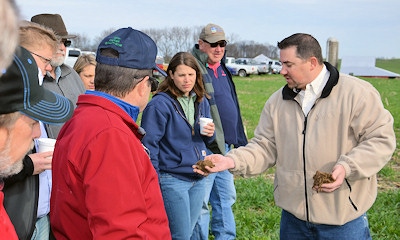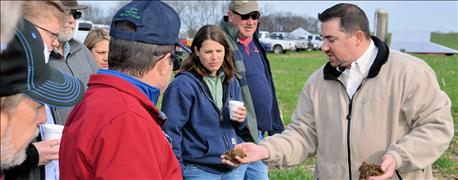
The calendar said it was spring, but a sharp wind reminded participants walking and looking at cover crop plots on Mark Lawson’s farm that Mother Nature doesn’t always read the calendar, nor long-term forecasts. She has a mind all her own.
Recently some 50 people gathered to see what Mark Lawson, Danville, was doing on this cover crop plots on his farm north of Danville. The highlight to the tour was walking the plots, wind or no wind. Here is what participants on the tour could have learned. The plot tour was sponsored by the Hendricks County Soil and Water Conservation District.
Take this virtual tour to see what participants learned. Just pretend you are cold and the wind is blowing!

BRAVE THE COLD: A crowd of people braved cold weather to see cover crop plots on Mark Lawson’s farm near Danville.
1. Cereal rye works best in front of soybeans.
“It does a great job suppressing marestail,” says Mike Starkey, Brownsburg, a conservation farmer on the tour. “If you plant corn into it, you must up the nitrogen rate in the starter. The residue ties up N until it releases it later in the season,” Starkey observes.

GOOD CROP IN FRONT OF SOYBEANS: You may want to burn it down soon if you’re new to cover crops. Mike Starkey prefers no-tilling soybeans into cereal rye, then burning it down.
2. Cover crops roots go deep even during the first year
Jared Chew crawled into a three-foot pit and found cover crop roots from annual ryegrass about three foot deep. What’s surprising is that this is the first year this field has been in cover crops. It has been in conventional tillage until this year. Chew, district conservationist in Hendricks and Marion County with NRCS, says it’s not unusual to find cover crop roots that deep in the soil.

LOOK AND SEE: Jared Chew pointed out roots from this first-time cover crop going several feet into the soil in very early spring.
3. Roots help break through compacted plow layer and loosen topsoil
This shovel full of soil taken from one of the cover corps on mark Lawson’s farm near Danville during the Hendricks County SWCD cover crop plot walk shows the improving structure of the soil. It’s from rooting, Chew says, and this is only the first year that this particular field has been in cover crops. Those who have used cover crops longer, like Mike Starkey, say it will eventually help loosen up compacted layers.

LOOSER SOIL: There’s no denying that the soil on the shovel looks healthy after one year of cover crops.
4. Legumes add nitrogen to the soil that should be available for crops
Bree Ollier of New Ross Grain holds a winter pea that was planted in a plot last fall. The legume can fix nitrogen and help produce nitrogen for the coming corp. She believes that it’s a good option to consider including to broaden your spectrum of what you can do with a cover crop.

CHECK OUT THE ROOTS: Nodules on the roots of the winter pea Bree Ollier is holding indicate that it was at work capturing N.
5. Radishes survived this winter but are easy to kill with herbicides
Normally radishes and turnips winterkill in most of Indiana. This year the winter was mild enough that radishes in these plots north of U.S. 40 didn’t die. However, Chew says they won’t be hard to bring down with herbicide. They are usually recommended along with oats as a good starter mix for beginners since they typically die during the winter.

RADISHES SURVIVE: Don’t be surprised if you see radishes still growing in cover crop fields this spring. The winter wasn’t severe enough to take them out in many cases.
About the Author(s)
You May Also Like




